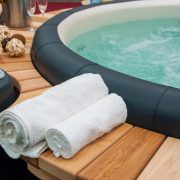As winter approaches, residents in cities experiencing extreme cold, like Hickory, NC, brace themselves for the chilly months ahead. In Hickory, the winter season is characterized by daily low temperatures hovering around 34°F, with colder spells often dropping below 19°F. The coldest day, on average, falls on January 24th, with a frigid low of 31°F. Moreover, the city sees a notable increase in snowfall during this season. The average sliding 31-day snowfall during winter starts at about 1.0 inches, rarely exceeding 4.4 inches, and gradually climbs to 2.1 inches, sometimes reaching up to 6.8 inches.
These harsh winter conditions make it imperative for homeowners to find effective ways to keep their houses warm and cozy. Ensuring warmth not only contributes to comfort but also the safety and well-being of residents. This article explores six surefire ways to combat the cold and maintain a warm and welcoming home during the winter months.
1. Innovative Heating Solutions
One innovative solution for maintaining warmth in the biting cold of cities like Hickory, NC, is the installation of dual fuel systems. Dual fuel systems are an efficient amalgamation of electric heat pumps and traditional gas or oil furnaces. This combination offers a versatile heating solution, adaptable to the fluctuating temperatures typical of a Hickory winter. When the temperature is moderately cold, the electric heat pump efficiently warms the house. So, as the mercury drops further, the system seamlessly switches to the furnace, providing the necessary warmth without excessive energy consumption.
The appeal of dual fuel systems in Hickory, NC, lies in their cost-effectiveness and energy efficiency. They are designed to choose the most economical heating method based on the external temperature, thereby reducing utility bills. Moreover, these systems provide a consistent heating experience, avoiding the temperature fluctuations that are common with standalone heating units. For Hickory residents, this means a comfortably warm home throughout the winter, regardless of the severe weather conditions outside.
2. Insulation Upgrades for Enhanced Warmth Retention
A key element in keeping a house warm is effective insulation. Proper insulation acts like a warm blanket around your home, trapping heat inside and blocking the cold outside air. Homes, especially older ones, often have areas with inadequate insulation, leading to significant heat loss and higher heating costs. Upgrading insulation is, therefore, a crucial step in winterizing a home.
The attic, walls, and floors are primary areas where insulation can make a significant difference. For example, adding loose-fill or batt insulation in the attic can prevent heat from rising and escaping through the roof. Insulating walls, particularly in older homes, can be done through blown-in insulation, a process that involves minimal disruption to the existing structure. In addition to these areas, insulating basements and crawl spaces can also help maintain a steady temperature throughout the house.
While the initial investment in upgrading insulation may seem substantial, the long-term savings in heating costs and the increased comfort it brings make it a worthwhile endeavor.
3. Weatherproofing Windows and Doors
Another critical step in keeping your home warm during the winter is effective weatherproofing of windows and doors. These areas are common culprits for drafts and heat loss. Simple weatherproofing measures can significantly reduce this loss, making your home more comfortable and reducing heating costs.
Weatherstripping is an effective and inexpensive way to seal gaps around windows and doors. It involves applying a strip of material around the frame to close the space where air can enter or escape. For windows, using clear plastic film kits can add a layer of insulation, trapping heat inside. Caulking is another useful method to seal any cracks or gaps in the window and door frames.
These weatherproofing measures not only keep the cold air out but also prevent warm air from escaping.
4. Smart Thermostat
In the quest to keep your home cozy during the chilly winters, particularly in regions like Hickory, NC, the integration of a smart thermostat is a game-changer. This advanced technology offers a high-tech solution to manage your home’s temperature effectively and efficiently. A smart thermostat is not just a programmable thermostat; it’s an intelligent system that learns your habits and adjusts the heating schedule accordingly.
The beauty of a smart thermostat lies in its ability to be controlled remotely via a smartphone or tablet. It means you can adjust your home’s temperature from anywhere, ensuring that your house is warm when you arrive. For residents of Hickory, where temperatures can fluctuate significantly, this feature is invaluable. The thermostat can also provide reports on your energy usage, helping you to understand and manage your heating costs better.
5. Utilizing Layered Curtains and Rugs for Added Insulation
Another effective yet often overlooked method to keep your house warm during winter is the strategic use of layered curtains and rugs. These elements add a layer of insulation to your rooms, trapping heat and keeping the cold at bay.
Thermal curtains are particularly effective for insulating windows, one of the primary sources of heat loss in a home. These curtains are made of heavy fabrics and sometimes have a thermal lining. When drawn during the coldest parts of the day or night, they act as a barrier against the cold coming from the windows. Similarly, using rugs on floors, especially if you have hardwood or tile, can provide additional insulation. Rugs not only add warmth underfoot but also help prevent heat from escaping through the floor.
Beyond their functional benefits, curtains, and rugs also offer an opportunity to enhance the aesthetics of your home.
6. Regular Maintenance of Heating Systems
One of the most crucial steps in ensuring a warm home during winter is the regular maintenance of your heating systems. Proper upkeep is essential for the efficiency and longevity of any heating system, be it a furnace, a boiler, or a heat pump.
A basic maintenance checklist should include cleaning or replacing filters, checking for leaks or blockages in the heating vents, and ensuring that the thermostat is functioning correctly. It’s also wise to have a professional technician inspect and service your heating system annually. They can perform more complex checks, such as examining the heat exchanger for cracks, testing for carbon monoxide leaks, and ensuring the system is operating at peak efficiency.
Regular maintenance not only ensures that your heating system is ready to face the winter but also improves its efficiency.
Conclusion
Keeping your house warm during the harsh winters requires a combination of modern technology and traditional methods. From installing dual fuel systems for efficient heating to sealing drafts with weatherproofing and using smart thermostats for optimal temperature control, each method contributes to a warmer, more comfortable home. Layering curtains and rugs adds insulation and aesthetic appeal, while regular maintenance of heating systems ensures long-term efficiency and reliability. By implementing these strategies, you can enjoy a cozy and warm living space, even in the coldest months, while managing your energy consumption and costs effectively.




















